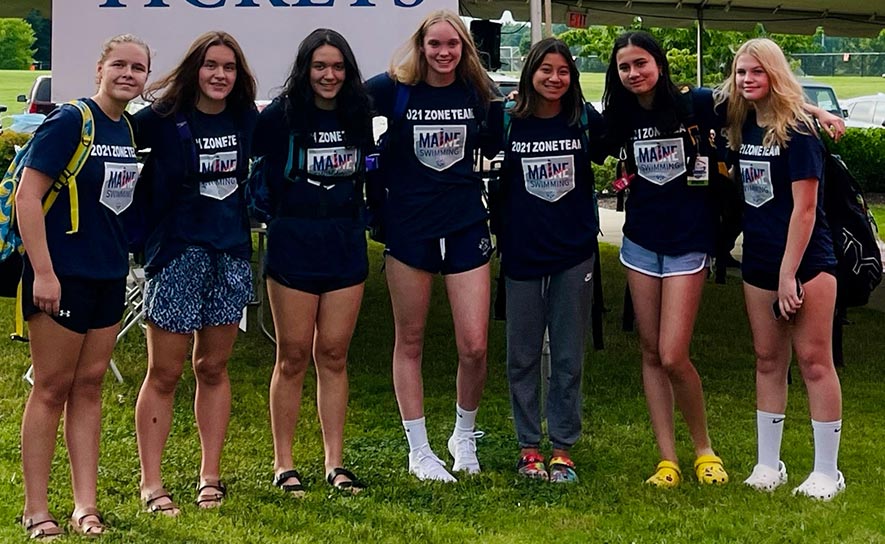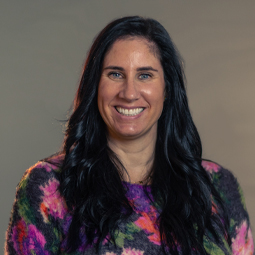USA Swimming News
Tuesday, August 31, 2021
Maine Swimming Sees Numerous Clubs Achieve USA Swimming Safe Sport Recognition

In July 2021, Maine Swimming Local Swimming Committee (LSC) joined a handful of other LSCs in achieving USA Swimming’s third-level incentive of the Safe Sport Club Recognition program. In order to achieve that level, 75% of the teams within the geographical territory inside the LSC must be Safe Sport recognized.
The distinction came as no surprise to Maine Swimming’s Safe Sport Chair Matt Montgomery and House of Delegates member Mary Ellen Tynan, because the LSC has been emphasizing the importance of completing the Safe Sport Club Recognition program since its inception. Montgomery and Tynan share the steps they’ve taken to implement Safe Sport policies within their state’s swimming community, and the positive impacts the policies are having on the sport in this month’s Safe Sport feature.
1. Maine swimming had five clubs earn Safe Sport recognition in July – was that a goal that you had for clubs within the LSC? Was there any kind of incentive for the teams to earn this recognition?
Maine Swimming has always believed that putting athletes first is of utmost priority. Our goals are awareness, action, voice and empowerment. When USA Swimming originally implemented the Safe Sport Club Recognition program, the Maine Swimming (MESI) board of directors felt it was important to take action to draw awareness to Safe Sport and implemented a $250 incentive to teams who completed the program. When USA Swimming implemented their own incentive program, MESI saw it as an additional opportunity to promote the athletes-first initiative and draw further attention to the importance of athlete safety. As a result of MESI's actions, 25% of our clubs had already been Safe Sport recognized when the USA Swimming program was announced. We missed the 50% incentive by one team, but we realized 75% was attainable so there was a push to reach this mark, and teams really stepped up to attest to Maine Swimming's mission.
2. As heads of the LSC, what role do the two of you play in making sure that clubs are complying with Safe Sport procedures?
We believe in leading by example. Matt has put together a great Safe Sport Committee that has a coach, athlete and parent representation to address athlete safety from all perspectives. The goal is to engage athletes, to give them a voice and empower them to make decisions. We have a very active, newly enlarged athlete committee with additional athletes across all boards and committees. We encourage athlete participation at all meetings and ask for input in all MESI initiatives. To increase awareness, before COVID we had a Safe Sport table at our winter championships and as we return to bigger meets, we anticipate this committee having a strong presence at larger meets with giveaways and prizes in conjunction with learning opportunities. Matt and I have held Safe Sport Zoom trainings in addition to ensuring that all standard USA Swimming safety procedures and sanction requirements are followed.
3. How do you think the Safe Sport program has impacted the sport of swimming and the culture within the sport?
Safe Sport has had a tremendously favorable impact on the sport of swimming for all involved. Athletes, coaches, volunteers, families and host facilities have all benefited from the improvement of communication standards, locker room policies and travel policies. Although many clubs were already facilitating similar standards, everyone benefits from the transparency of rules and regulations. For newer clubs, having a governing body develop templates and provide training to become Safe Sport compliant is incredibly helpful. Probably the biggest impact is the athlete voice. The Safe Sport program has encouraged LSCs to put athletes first and give them a strong voice within the LSC. More conversations are being had with less fear of stigma around the topic. The sport of swimming is definitely a safer place for all involved thanks to the awareness brought on through the efforts of USA Swimming’s Safe Sport program.
4. What advice would you give other LSC leaders in implementing Safe Sport policies within their LSC’s clubs?
Lead by example. Safe Sport and its policies are touch points for conversations. LSC leaders need to step up and demonstrate their commitment to their athletes and their safety. Funding helps invest in the things teams need to do to put athletes first. Also, reach out to those clubs that haven't achieved Safe Sport Club Recognition to see what they need help with. Invite someone from that club (athlete, board member, assistant coach, etc.) to become part of the LSC's Safe Sport committee. That person may help get the wheels turning in order to help that club get started - or finish the requirements. Lastly, celebrate those clubs that have achieved Safe Sport Club Recognition through social media, or at LSC sponsored events, or anywhere that a member of a club that hasn't implemented the policies may see what other clubs are doing in the hopes that it encourages them to get on board.
The distinction came as no surprise to Maine Swimming’s Safe Sport Chair Matt Montgomery and House of Delegates member Mary Ellen Tynan, because the LSC has been emphasizing the importance of completing the Safe Sport Club Recognition program since its inception. Montgomery and Tynan share the steps they’ve taken to implement Safe Sport policies within their state’s swimming community, and the positive impacts the policies are having on the sport in this month’s Safe Sport feature.
1. Maine swimming had five clubs earn Safe Sport recognition in July – was that a goal that you had for clubs within the LSC? Was there any kind of incentive for the teams to earn this recognition?
Maine Swimming has always believed that putting athletes first is of utmost priority. Our goals are awareness, action, voice and empowerment. When USA Swimming originally implemented the Safe Sport Club Recognition program, the Maine Swimming (MESI) board of directors felt it was important to take action to draw awareness to Safe Sport and implemented a $250 incentive to teams who completed the program. When USA Swimming implemented their own incentive program, MESI saw it as an additional opportunity to promote the athletes-first initiative and draw further attention to the importance of athlete safety. As a result of MESI's actions, 25% of our clubs had already been Safe Sport recognized when the USA Swimming program was announced. We missed the 50% incentive by one team, but we realized 75% was attainable so there was a push to reach this mark, and teams really stepped up to attest to Maine Swimming's mission.
2. As heads of the LSC, what role do the two of you play in making sure that clubs are complying with Safe Sport procedures?
We believe in leading by example. Matt has put together a great Safe Sport Committee that has a coach, athlete and parent representation to address athlete safety from all perspectives. The goal is to engage athletes, to give them a voice and empower them to make decisions. We have a very active, newly enlarged athlete committee with additional athletes across all boards and committees. We encourage athlete participation at all meetings and ask for input in all MESI initiatives. To increase awareness, before COVID we had a Safe Sport table at our winter championships and as we return to bigger meets, we anticipate this committee having a strong presence at larger meets with giveaways and prizes in conjunction with learning opportunities. Matt and I have held Safe Sport Zoom trainings in addition to ensuring that all standard USA Swimming safety procedures and sanction requirements are followed.
3. How do you think the Safe Sport program has impacted the sport of swimming and the culture within the sport?
Safe Sport has had a tremendously favorable impact on the sport of swimming for all involved. Athletes, coaches, volunteers, families and host facilities have all benefited from the improvement of communication standards, locker room policies and travel policies. Although many clubs were already facilitating similar standards, everyone benefits from the transparency of rules and regulations. For newer clubs, having a governing body develop templates and provide training to become Safe Sport compliant is incredibly helpful. Probably the biggest impact is the athlete voice. The Safe Sport program has encouraged LSCs to put athletes first and give them a strong voice within the LSC. More conversations are being had with less fear of stigma around the topic. The sport of swimming is definitely a safer place for all involved thanks to the awareness brought on through the efforts of USA Swimming’s Safe Sport program.
4. What advice would you give other LSC leaders in implementing Safe Sport policies within their LSC’s clubs?
Lead by example. Safe Sport and its policies are touch points for conversations. LSC leaders need to step up and demonstrate their commitment to their athletes and their safety. Funding helps invest in the things teams need to do to put athletes first. Also, reach out to those clubs that haven't achieved Safe Sport Club Recognition to see what they need help with. Invite someone from that club (athlete, board member, assistant coach, etc.) to become part of the LSC's Safe Sport committee. That person may help get the wheels turning in order to help that club get started - or finish the requirements. Lastly, celebrate those clubs that have achieved Safe Sport Club Recognition through social media, or at LSC sponsored events, or anywhere that a member of a club that hasn't implemented the policies may see what other clubs are doing in the hopes that it encourages them to get on board.
For more information on USA Swimming's Safe Sport Recognition Program, visit www.usaswimming.org/ssrp.
Related Articles
ARTICLE
Huske, Finke, DeSorbo Named Athletes and Coach of the Year at 2024 Golden Goggle Awards, Presented OMEGA Timepieces
Nov 27, 2024
ARTICLE
Asheville Jewish Community Center Gives Back After Hurricane Helene
Nov 25, 2024
ARTICLE
Olympians and Swim Community Celebrate 2024 Golden Goggle Awards
Nov 24, 2024
ARTICLE
2023-24 Scholastic All-America Team Announced
Nov 13, 2024
ARTICLE
Leverenz Smith, Meili Elected to USA Swimming Board of Directors
Nov 12, 2024
ARTICLE
USA Swimming Recognizes 2024-25 Club Excellence Recipients
Oct 30, 2024
ARTICLE
Athlete Roster Announced for 2024 National Select Camp
Oct 29, 2024
ARTICLE
USA Swimming, USA Swimming Foundation Open 2025 Community Impact Grant Applications
Oct 7, 2024
ARTICLE
USA Swimming, USA Swimming Foundation Open 2025 Historically Black Colleges and Universities Grant Applications
Oct 7, 2024

